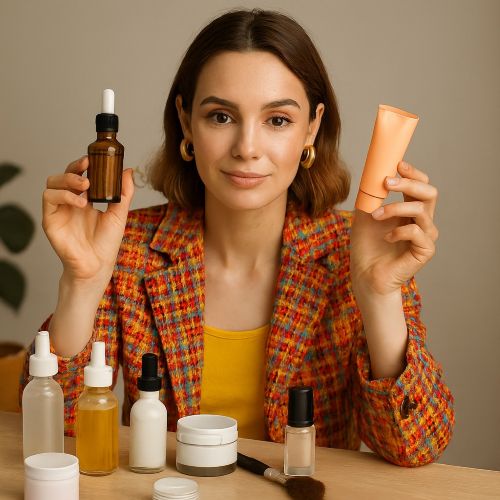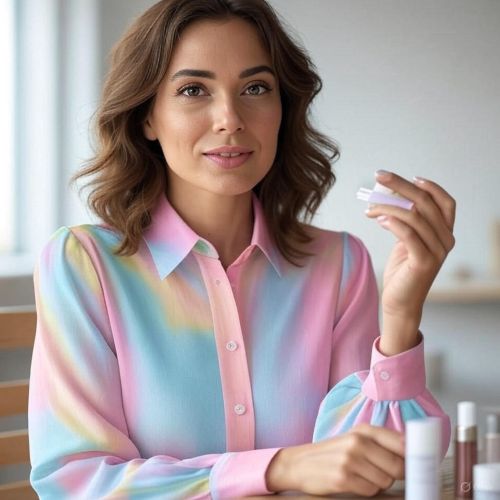-
 DIY: Video master classes
DIY: Video master classes
-
 Aromatherapy
Aromatherapy
-
 Felting master classes
Felting master classes
-
 Eating at home
Eating at home
-
 DIY cosmetics for children
DIY cosmetics for children
-
 Cooking recipes
Cooking recipes
-
 Detergents, cleaning products with your own hands
Detergents, cleaning products with your own hands
-
 Soap making as a business
Soap making as a business
-
 Natural cosmetics. Raw materials for cosmetics and soap.
Natural cosmetics. Raw materials for cosmetics and soap.
-
 Natural oils in cosmetics
Natural oils in cosmetics
-
 News
News
-
 Recipes for balms and conditioners
Recipes for balms and conditioners
-
 Bath Bomb Recipes
Bath Bomb Recipes
-
 Cream recipes. Cream making.
Cream recipes. Cream making.
-
 Lotion recipes. Gel recipes.
Lotion recipes. Gel recipes.
-
 Mask recipes
Mask recipes
-
 Soap recipes. Base soap. Soap from scratch.
Soap recipes. Base soap. Soap from scratch.
-
 Recipes for all occasions
Recipes for all occasions
-
 Natural shampoo recipes
Natural shampoo recipes
-
 Healthy Nutrition Recipes
Healthy Nutrition Recipes
-
 Scrub recipes. Massage tiles. Ubtan
Scrub recipes. Massage tiles. Ubtan
-
 DIY candles
DIY candles
-
 Reference materials, questions, tips
Reference materials, questions, tips
-
 Startup - soap production
Startup - soap production
-
 Hair care. Tips, recipes
Hair care. Tips, recipes
-
 Facial skin care. Cleansers.
Facial skin care. Cleansers.
-
 Body care. Tips, recipes
Body care. Tips, recipes
-
 Photo Reviews
Photo Reviews
-
 Chocolate Handmade
Chocolate Handmade
How to launch a cosmetic brand from scratch: a step-by-step plan with the choice of raw materials
 Starting a cosmetic brand from the ground up is a dream for many, but it can seem overwhelming. From formulating products to building a brand identity and navigating legal requirements, the path is full of challenges. However, with a clear plan and a passion for quality, it's an achievable goal. This article provides a comprehensive, step-by-step guide on how to launch a cosmetic brand from scratch, focusing on the crucial aspects of concept development, raw material selection, and formulation. We'll outline a practical plan, provide three sample recipes that you can adapt, and highlight the key advantages of creating your own unique product line.
Starting a cosmetic brand from the ground up is a dream for many, but it can seem overwhelming. From formulating products to building a brand identity and navigating legal requirements, the path is full of challenges. However, with a clear plan and a passion for quality, it's an achievable goal. This article provides a comprehensive, step-by-step guide on how to launch a cosmetic brand from scratch, focusing on the crucial aspects of concept development, raw material selection, and formulation. We'll outline a practical plan, provide three sample recipes that you can adapt, and highlight the key advantages of creating your own unique product line.
Step 1: Defining Your Brand and Niche
Before you can even think about ingredients, you must define your brand's core identity. What makes you different? Who is your target audience? A clear brand concept will guide all your future decisions.
-
Identify a unique selling proposition (USP). Are you focusing on sustainable, zero-waste products? Are you an expert in anti-aging or sensitive skin care? Do you use local, ethically sourced ingredients? Your USP is what sets you apart from the competition.
-
Define your target audience. Who are you creating products for? A younger, trend-conscious demographic, or an older audience seeking effective anti-aging solutions? Understanding your customer will influence everything from your packaging to your marketing strategy.
-
Create a business plan. Outline your mission, vision, and financial projections. Research the market, analyze your competitors, and determine your pricing strategy. A solid business plan is your roadmap to success.
Step 2: Sourcing Raw Materials and Formulation
This is the heart of your brand. The quality and safety of your products depend entirely on your raw materials and a well-designed formula.
-
Choose a reliable supplier. Research and choose a reputable supplier for your cosmetic ingredients. Look for companies that provide clear documentation, including certificates of analysis (COA) and safety data sheets (SDS). These documents are crucial for ensuring the quality, purity, and safety of your raw materials.
-
Understand ingredient categories. Differentiate between base components (oils, butters, waxes, water, emulsifiers) that form the structure of your product and active ingredients (peptides, vitamins, plant extracts) that provide a specific benefit.
-
Start with simple formulas. Begin by creating simple, stable formulations. Focus on mastering the basics of emulsion making, proper pH balancing, and preservation. Don't add too many actives at once. This reduces the risk of incompatibility and allows you to understand how each ingredient works.
-
Test everything. Test your final products for stability, pH, and efficacy. Make small batches and monitor them over time to ensure they remain stable. This is a crucial step before scaling up.
Step 3: Legal Compliance and Branding
Once you have a great product, you need to make it legal and appealing.
-
Legal requirements and certification. Research the cosmetic regulations in your country. This may include a list of permitted ingredients, required testing, and proper labeling guidelines. In many regions, you need to register your formulas and comply with good manufacturing practices (GMP).
-
Packaging and labeling. Your packaging should reflect your brand identity. Choose containers that are not only visually appealing but also functional and safe. Your labels must be accurate and include a full INCI list of ingredients, instructions, and a best-by date.
-
Marketing and sales strategy. Create a marketing plan that includes social media, content creation, and an e-commerce platform. Start with a small launch and grow from there.
Three Recipes to Get You Started
These three detailed recipes provide a solid foundation for your first product line. They are simple to formulate and can be customized with your unique actives.
Recipe 1: Nourishing Daily Facial Moisturizer
This is a stable, hydrating emulsion that is perfect for a starter product.
-
Prepare the water phase. In a sterilized beaker, combine 65g of distilled water and 5g of vegetable glycerin. Heat this phase to 70°C.
-
Prepare the oil phase. In a separate beaker, combine 10g of shea butter, 10g of jojoba oil, and 5g of the emulsifier BTMS-50. Heat this phase to 70°C, stirring until all ingredients are melted.
-
Emulsify. Pour the water phase into the oil phase while mixing with a hand blender. Blend in short pulses until a smooth, thick emulsion forms. Continue mixing as the lotion cools.
-
Add actives and preservative. When the temperature drops below 40°C, add 2g of niacinamide powder and 2g of panthenol. Stir to fully dissolve. Add 1g of a broad-spectrum preservative like Geogard 221 and stir well.
-
Package and label. Transfer the finished moisturizer to an air-tight jar or pump bottle. Label it with the full INCI list.
Advantages over Industrial Products: You can use higher concentrations of premium oils and actives. This formula avoids common synthetic additives found in mass-market lotions.
Recipe 2: Hydrating Hyaluronic Acid Serum
A simple, effective, and popular product to start with.
-
Prepare the gel phase. In a sterilized beaker, weigh 90g of distilled water. Slowly sprinkle 1g of hyaluronic acid powder over the surface. Do not stir immediately; let the powder hydrate for 30 minutes to an hour.
-
Add the active and humectant. Once a clear gel has formed, add 2g of glycerin and 2g of a liquid botanical extract of your choice (e.g., chamomile or green tea).
-
Add the preservative. Add 1g of a broad-spectrum preservative like Euxyl PE 9010. Stir gently until all ingredients are fully incorporated.
-
Adjust pH and package. Check the pH. It should be between 5.0 and 6.0. Adjust if necessary. Pour the finished serum into a dropper bottle.
Advantages over Industrial Products: This formula contains a high percentage of pure hyaluronic acid, unlike commercial serums that often contain minimal amounts. It is free of unnecessary fillers and fragrances.
Recipe 3: Soothing Oil-Based Cleansing Balm
This formula is a great starter product as it doesn't require a preservative, simplifying the process.
-
Prepare the oils and emulsifier. In a heat-safe beaker, combine 40g of shea butter and 15g of cocoa butter. Add 20g of a mild emulsifier like Polysorbate 80. Gently melt the ingredients in a double boiler.
-
Add the liquid oils. Once the butters and emulsifier are melted, remove the beaker from the heat. Add 15g of sweet almond oil and 10g of jojoba oil. Stir well to combine.
-
Add actives and fragrance. When the mixture has cooled slightly, add 0.5g of vitamin E (Tocopherol) and 10 drops of a skin-safe essential oil blend (optional).
-
Package. Pour the liquid balm into a clean glass jar. Allow it to cool and solidify completely before capping.
Advantages over Industrial Products: This balm melts luxuriously on the skin and rinses clean without a greasy residue, thanks to the emulsifier. It's free of synthetic fragrances and mineral oils.
Key Advantages of Your Own Brand

Launching your own brand gives you a distinct advantage over competitors who rely on generic, mass-produced formulas.
-
Quality Control: You have complete control over the quality of every single ingredient, ensuring purity and efficacy.
-
Ingredient Transparency: You can be completely transparent with your customers about what is in your products, building trust and a loyal following.
-
Niche Focus: By creating products tailored to a specific need or audience, you can provide a solution that large companies often overlook.
-
Creative Freedom: You have the freedom to experiment with unique ingredients and create a product line that truly reflects your values and vision.
Launching your own brand is a journey of creativity, learning, and hard work. But by focusing on quality, safety, and a clear brand identity, you can build a successful business that brings your passion to life.
Mylo Opt Cosmetics Blog – Your Reliable Guide to Beauty and Care
Welcome to the Mylo Opt cosmetics blog! Here, you will find valuable advice, interesting recipes, and professional recommendations for creating soap, cosmetics, and candles with your own hands. Our blog is designed for anyone passionate about natural cosmetics, looking for new ideas, and wanting to learn more about producing high-quality skincare and haircare products. We share tested recipes, useful tips, and the latest news from the world of cosmetics.
Why Choose the Mylo Opt Cosmetics Blog?
Mylo Opt is not just an online store; it is a community of people passionate about creating natural cosmetics. Here are a few reasons why our blog will be useful to you:
- Experience and Expertise: Our authors are experienced cosmetologists, soap makers, and aromatherapy specialists. We share reliable and tested recipes that have undergone thorough testing and received positive feedback.
- Credibility and Authority: We ensure that all information in our blog is up-to-date and reliable. We reference scientific research and verified sources so that you can trust the quality of the information provided.
- Reader-Focused: Our content is tailored to you – our readers. We strive to answer your questions, solve your problems, and inspire new achievements in the world of natural cosmetics.
Popular Products from the Mylo Opt Online Store
Before we move on to recipes and tips, let us introduce you to the most popular products from our online store, which will help you create high-quality and natural cosmetics:
- Soap Bases: High-quality soap bases allow you to create beautiful and beneficial handmade soaps. We offer glycerin bases, bases with added oils and extracts, as well as transparent and white bases.
- Fragrance Oils and Fragrances: Give your products a unique scent with our fragrance oils and fragrances. We offer a wide range of scents – from fresh and floral to spicy and woody.
- Essential Oils: Essential oils are natural components that not only add fragrance to products but also offer beneficial properties for the skin and hair. Our range includes lavender, mint, eucalyptus, lemon, and many other oils.
- Active Ingredients: Vitamins, antioxidants, hyaluronic acid, and other active ingredients help improve the properties of your cosmetics. We offer only tested and high-quality components.
- Pigments and Dyes: Give your products bright and lasting colors with our pigments and dyes. They are safe for the skin and suitable for use in soap, cosmetics, and candles.
- Emulsifiers and Thickeners: To create creams and lotions, you will need emulsifiers and thickeners. We offer quality ingredients that help you achieve the desired consistency and stability of the product.
- Soap and Candle Molds: Create unique items with our soap and candle molds. Our range includes molds of various sizes and designs.
- Everything for Candles: Wax, wicks, fragrances, and dyes for candles – we have everything you need to create beautiful and fragrant candles.
Recipes and Tips for Making Handmade Soap
Cold Process Soap for Beginners
Making cold process soap is an exciting process that allows you to control all the ingredients and create unique recipes. Here is one simple cold process soap recipe for beginners:
Ingredients:
- 500 g olive oil
- 300 g coconut oil
- 200 g palm oil
- 150 g castor oil
- 120 g lye (sodium hydroxide)
- 300 ml distilled water
- Essential oils (lavender, mint, eucalyptus)
- Pigments or natural dyes (optional)
Process:
- Prepare all ingredients and tools. Always use protective gloves and goggles, as lye can be dangerous.
- Weigh the lye and water. Slowly add the lye to the water, stirring until it fully dissolves. Allow the mixture to cool to 40-45°C.
- Weigh the oils and melt them in a water bath. When the oils and lye solution reach the same temperature (about 40-45°C), slowly pour the lye into the oils, stirring constantly.
- Use an immersion blender to mix until trace (when the mixture thickens and leaves a trail when stirred).
- Add essential oils and pigments if desired. Mix thoroughly.
- Pour the mixture into a prepared mold and cover with a towel. Let the soap harden for 24-48 hours.
- Remove the soap from the mold and cut it into bars. Allow the soap to cure for 4-6 weeks before use.
Homemade Cosmetics Recipes
DIY Moisturizing Cream
Creating a moisturizing cream at home allows you to control the ingredients and adapt the recipe to your needs. Here is a simple recipe for a moisturizing cream:
Ingredients:
- 50 ml rose water
- 50 ml distilled water
- 10 g emulsifier (e.g., Olivem 1000)
- 10 ml jojoba oil
- 5 ml avocado oil
- 5 drops lavender essential oil
- 2 drops tea tree essential oil
Process:
- Weigh all the ingredients.
- In a water bath, melt the emulsifier with the oils until smooth.
- Separately, heat the water phase (rose water and distilled water) to the same temperature as the oil phase.
- Slowly pour the water phase into the oil phase, stirring constantly.
- Use an immersion blender to emulsify until you achieve a creamy consistency.
- Add essential oils and mix thoroughly.
- Pour the cream into a sterilized jar and allow it to cool.
DIY Candle Recipes
Aromatic Soy Candle
Creating aromatic candles is a creative process that allows you to experiment with scents and designs. Here is a simple recipe for a soy candle:
Ingredients:
- 200 g soy wax
- 20 ml fragrance oil (e.g., vanilla or lavender)
- Wick for candles
- Dyes (optional)
- Glass or metal candle mold
Process:
- Melt the soy wax in a water bath until liquid.
- Add the fragrance oil and dyes if desired. Mix thoroughly.
- Secure the wick in the center of the candle mold.
- Slowly pour the melted wax into the mold, holding the wick.
- Allow the candle to fully harden (about 24 hours).
- Trim the wick to the desired length and enjoy your aromatic candle.
Tips for Beginners in Cream Making
- Learn the Basics: Before starting to create creams, it is important to learn the basic principles and ingredients used in cream making.
- Experiment with Formulas: Do not be afraid to experiment with different ingredients and proportions to find the perfect formula for your skin.
- Use Quality Ingredients: The effectiveness and safety of your product depend on the quality of the ingredients. Always choose tested and natural components.
- Maintain Hygiene: It is important to maintain cleanliness and sterility when creating cosmetics to avoid contamination and spoilage of the product.
- Start with Simple Recipes: For beginners, it is best to start with simple recipes to master the basic techniques and principles of cream making.
Conclusion
Our Mylo Opt cosmetics blog is your reliable source of information and inspiration in the world of natural cosmetics. We share useful tips, tested recipes, and the latest news to help you create quality and effective products for skin, hair, and home care. Subscribe to our blog, follow the updates, and discover new opportunities in the world of natural cosmetics with Mylo Opt!





